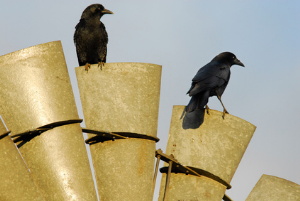Wind Turbines and Bird Deaths: The Controversy Continues
 Do commercial wind energy systems pose a threat to birds and other flying creatures? Are bats and birds being battered out of the air by rotating wind turbine blades, as has been reported by some in the mainstream media?
Do commercial wind energy systems pose a threat to birds and other flying creatures? Are bats and birds being battered out of the air by rotating wind turbine blades, as has been reported by some in the mainstream media?
It’s an issue that has been debated and studied on a routine basis by wind industry specialists and conservationists and no doubt will continue as time goes on.
Interestingly though, one must consider all the natural and man-made “enemies” that challenge a bird’s lifespan. There are any number of things that can cause their individual deaths or full-flock demise. When we look collectively at all these ways that tweety-bird may meet his maker before his time, a collision with a wind turbine seems like to least of his worries..
In the first year of a bird’s life, research shows that about 30% of total deaths are caused by natural collisions (the “landing” learning curve for young birds is apparently quite steep). Those that are lucky enough to enter the second year of life will face man-induced perils such as Sylvester the domesticated cat, collisions with automobiles (60 to 80 million birds perish annually), not to mention intimate encounters with residential and commercial windows. But tweety isn’t in the clear yet, add in transmission and distribution lines for electricity and other utilities, communication towers, and agricultural pesticides– the staggering numbers for bird deaths due to human infrastructure and industrial activities are estimated at one to four million feathered friends per day!
So now that we’ve pretty much established that a bird has pretty slim odds from the get-go, what exactly is the mortality rate from wind turbines?
According to the 2001 National Wind Coordinating Committee study, “Avian Collisions with Wind Turbines: A Summary of Existing Studies and Comparisons to Other Sources of Avian Collision Mortality in the United States,” these non-wind mortalities compare with 2.19 bird deaths per turbine per year. That’s a long way from the sum mortality caused by the other sources. Commercial wind development continues to grow exponentially, with more than 25,000 turbines on the U.S. landscape today, and a projected 155,000 or more turbines within the next 10 years.
According to Laurie Jodziewicz, communications and policy specialist for the American Wind Energy Association, the most important aspect for minimizing impact on wildlife is siting. Laurie states that “When many people think of wind turbines and bird fatalities, Altamont Pass Wind Resource Area in California usually comes to mind, where unfortunately a large number of birds have died. This facility was the first commercial wind project here in the United States and was installed without understanding that there might be impacts to the raptor population in the area. Today, we wouldn’t construct a project in that same area, and subsequent projects did a much better job at considering impacts to birds before construction began. These pre-construction studies help us better understand how to mitigate impacts and are now part and parcel of the development process. Outside of Altamont Pass, we haven’t seen any projects that have significant impacts on birds.”
As with many things in life, a single negative instance takes precedence over multiple instances of positive results, and sometimes the media and particular conservation groups will over-focus on this one unfortunate circumstance and we lose sight of what we’ve learned. In any case, there continues to be many outstanding minds working together to help solve these challenges. While there are no deterrent devices (ultrasound, infrasound, or lasers) that have shown great promise, there are some tools that may help in avoiding and minimizing adverse wildlife impacts (blade “feathering,” increased blade “cut-in” speeds, project set-backs, and more). The bottom line is, while wind farms are responsible for the deaths of some birds, when put into the perspective of other causes of avian mortality, the impact is quite low.
Recent Comments